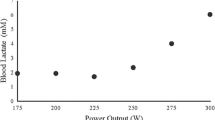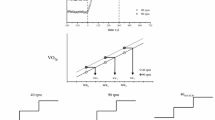Abstract
Critical power (CP) and the second ventilatory threshold (VT2) are presumed to indicate the power corresponding to maximal lactate steady state (MLSS). The aim of this study was to investigate the use of CP and VT2 as indicators of MLSS. Eleven male trained subjects [mean (SD) age 23 (2.9) years] performed an incremental test (25 W·min−1) to determine maximal oxygen uptake (V̇O2max), maximal aerobic power (MAP) and the first and second ventilatory thresholds (VT1 and VT2) associated with break points in minute ventilation (V̇E), carbon dioxide production (V̇CO2), V̇E/V̇CO2 and V̇E/V̇O2 relationships. Exhaustion tests at 90%, 95%, 100% and 110% of V̇O2max and several 30-min constant work rates were performed in order to determine CP and MLSS, respectively. MAP and V̇O2max values were 344 (29) W and 53.4 (3.7) ml·min−1·kg−1, respectively. CP [278 (22) W; 85.4 (4.8)% V̇O2max] and VT2 power output [286 (28) W; 85.3 (5.6)% V̇O2max] were not significantly different (p=0.96) but were higher (p<0.05) than the MLSS work rate [239 (21) W; 74.3 (4.0)% V̇O2max] and VT1 power output [159 (23) W; 52.9 (6.9)% V̇O2max]. MLSS work rate was significantly correlated (p<0.05) with those noted at VT1 and VT2 (r=0.74 and r=0.93, respectively). VT2 overestimated MLSS by 10.9 (6.3)% V̇O2max which was significantly higher than VT1 [+21.4 (5.6)% V̇O2max; p<0.01]. CP calculated from a given range of exhaustion times does not correspond to MLSS.



Similar content being viewed by others
References
Beaver WL, Wasserman K, Whipp BJ (1986) A new method for detecting anaerobic threshold by gas exchange. J Appl Physiol 60:2020–2027
Beneke R (1995) Anaerobic threshold, individual anaerobic threshold, and maximal lactate steady state in rowing. Med Sci Sports Exerc 27:863–867
Bishop D, Jenkins DG, Howard A (1998) The critical power function is dependent on the duration of the predictive exercise tests chosen. Int J sports Med 19:125–129
Brickley G, Doust J, Williams CA (2002) Physiological responses during exercise to exhaustion at critical power. Eur J Appl Physiol 10.1007/s00421-002-0706-1
Brisswalter J, Hausswirth C, Smith D, Vercruyssen F, Vallier JM (1999) Energetically optimal cadence vs. freely-chosen cadence during cycling: effect of exercise duration. Int J Sports Med 20:60–64
Brooks GA (1985) Anaerobic threshold: review of the concept and directions for future research. Med Sci Sports Exerc 17:22–31
Carnevale TJ, Gaesser GA (1991) Effects of pedalling speed on the power-duration relationship for high-intensity exercise. Med Sci Sports Exerc 23:242–246
Davis JA (1985) Anaerobic threshold: review of the concept and directions for future research. Med Sci Sports Exerc 17:6–21
Gaesser GA, Wilson LA (1988) Effects of continuous and interval training on the parameters of the power–endurance relationship for high intensity exercise. Int J Sports Med 9:417–421
Greenhouse SW, Geisser S (1959) On methods in the analysis of profile data. Psychometrika 24:95–112
Harrison TR, Pilcher C (1930) Studies in congestive heart failure: II. The respiratory exchange during and after exercise. J Clin Invest 8:291
Heck H, Mader A, Hesse G, Mucke S, Muller R, Hollmann W (1985) Justification of the 4- mmol·l−1 lactate threshold. Int J Sports Med 6:117–130
Hill AV, Long CNH, Lupton H (1924) Muscular exercise lactic acid and the supply and utilization of oxygen: Part VII. Muscular exercise and oxygen intake. Proc R Soc Lond [B] 97:155–167
Hill DW (1993) The critical power concept. Sports Med 16:237–254
Hill DW, Smith JC, Leuschel JL, Chasteen SD, Miller SA (1995) Effect of pedal cadence on parameters of the hyperbolic power–time relationship. Int J Sports Med 16:82–87
Hollman W (1959) The relationship between pH, lactic acid, potassium in arterial and venous blood, the ventilation (PoW) and pulse frequency during increasing spirometric work in endurance-trained and untrained persons. Pan-American Congress for Sports Medicine, Chicago, Ill.
Housh DJ, Housh TJ, Bauge SM (1989) The accuracy of the critical power test for predicting time to exhaustion during cycle ergometer. Ergonomics 32:997–1004
Housh TJ, Devries HA, Housh DJ, Tichy MW, Smyth KD, Tichy A (1991) The relationship between critical power and the onset of blood lactate accumulation. J Sports Med Phys Fitness 31:31–36
Hughes E, Turner S, Brooks G (1982) Effects of glycogen depletion and pedaling speed on "anaerobic threshold". J Appl Physiol 52:1598–1607
Hughson RL, Orok CJ, Staudt LE (1984) A high velocity treadmill running test to assess endurance running potential. Int J Sports Med 5:23–25
Jenkins DG, Quigley BM (1990) Blood lactate in trained cyclists during cycle ergometry at critical power. Eur J Appl Physiol 61:278–283
Kinderman W, Simon G, Keul J (1979) The significance of the aerobic-anaerobic transition for determination of workload intensities during endurance training. Eur J Appl Physiol 42:25–34
Loat CER, Rhodes EC (1993) Relationship between lactate and ventilatory thresholds during prolonged exercise. Sports Med 15:104–115
McLellan TM, Cheung KS (1992) A comparative evaluation of the individual anaerobic threshold and the critical power. Med Sci Sports Exerc 24:543–550
McLellan TM, Skinner JS (1981) The use of the aerobic threshold as basis of training. Can J Appl Sports Sci 6:197–201
Moritani T, Nagata A, De Vries HA, Muro M (1981) Critical power as a measure of physical work capacity and anaerobic threshold. Ergonomics 24:339–350
Owles WH (1930) Alterations in the lactic acid content of the blood as a result of light exercise, and associated changes in CO2 combining power of the blood and into alveolar CO2 pressure. J Physiol (Lond) 69 214–237
Poole DC, Ward SA, Gardner GW, Whipp BJ (1988) A metabolic and respiratory profile of the upper limit for prolonged exercise in man. Ergonomics 31:1265–1279
Pringle JSM, Jones AM (2002) Maximal lactate steady state, critical power and EMG during cycling. Eur J Appl Physiol 10.1007/s00421-002-0703-4
Scherrer J, Monod H (1960) Le travail musculaire local et la fatigue chez l'homme. Masson et Compagnie, Paris
Shapiro SS, Wilk MB, Chen HJ (1968) A comparative study of various tests of normality. J Am Stat Assoc 63:1343–1372
Smith CGM, Jones AM (2001) The relationship between critical velocity, maximal lactate steady-state velocity and lactate turnpoint velocity in runners. Eur J Appl Physiol 85:19–26
Stevens J (1996) Applied multivariate statistics for the social sciences. Erlbaum, Mahwah, NJ, USA
Takaishi T, Yasuda Y, Moritani T (1994) Neuromuscular fatigue during prolonged pedaling exercise at different pedaling rates. Eur J Appl Physiol 69:154–158
Takano N (1988) Effects of pedal rates on respiratory responses to incremental bicycle work. J Physiol (Lond) 396:389–397
Vallier JM, Bigard AX, Carré F, Eclache JP, Mercier J (2000) Détermination des seuils lactiques et ventilatoires. Position de la société française de médecine du sport. Sci Sports 15:133–140
Vandewalle H, Vautier JF, Kachouri M, Lechevalier JM, Monod H (1997) Work–exhaustion time relationships and the critical power concept. J Sports Med Phys Fitness 37:89–102
Vercruyssen F, Hausswirth C, Smith D, Brisswalter J (2001) Effect of exercise duration on optimal pedalling rate choice in triathletes. Can J Appl Physiol 26:44–54
Wakayoshi K, Yoshida T, Udo M, Haradaa T, Moritani T, Mutoh Y, Miyashita M (1993) Does critical swimming velocity represent exercise intensity at maximal lactate steady state? Eur J Appl Physiol 66:90–95
Wasserman K, McIlroy MB (1964) Detecting the threshold of anaerobic metabolism in cardiac patients during exercise. Am J Cardiol 14:844–852
Wasserman K, Whipp BJ, Koyl SN, Beaver WL (1973) Anaerobic threshold and respiratory gas exchange during exercise. J Appl Physiol 35:236–243
Weissland T, Pelayo P, Vanvelcenaeher J, Marais G, Lavoie JM, Robin H (1997) Physiological effects of variations of spontaneously chosen crank rates in incremental upper body exercise. Eur J Appl Physiol 76:428–433
Weissland T, Marais G, Robin H, Vanvelcenaeher J, Pelayo P (1999) Relationship in humans between spontaneously chosen crank rate and power output during upper body exercise at different levels of intensity. Eur J Appl Physiol 79:230–236
Winter EM, Eston RG, Lamb K (2001) Statistical analysis in the physiology of exercise and kinanthropometry. J Sports Sci 19:761–775
Yamamoto Y, Mizashita M, Hughson RL, Tamura S, Shinohara M, Mutoh Y (1991) The ventilatory threshold gives maximal lactate steady state. Eur J Appl Physiol 63:55–59
Acknowledgements
The authors would like to thank all the participants and more particularly, D. Boy and Dr. P. Camblin for their enthusiastic co-operation
Author information
Authors and Affiliations
Corresponding author
Rights and permissions
About this article
Cite this article
Dekerle, J., Baron, B., Dupont, L. et al. Maximal lactate steady state, respiratory compensation threshold and critical power. Eur J Appl Physiol 89, 281–288 (2003). https://doi.org/10.1007/s00421-002-0786-y
Accepted:
Published:
Issue Date:
DOI: https://doi.org/10.1007/s00421-002-0786-y




